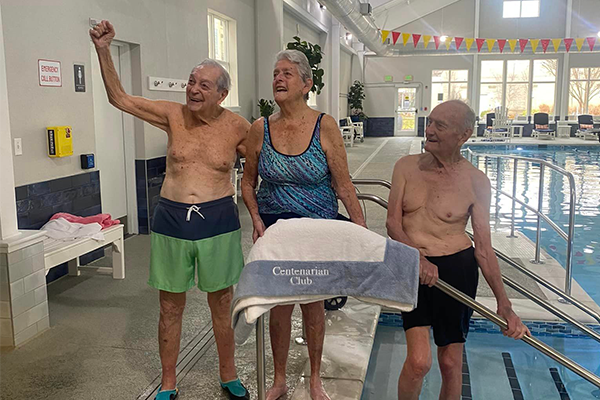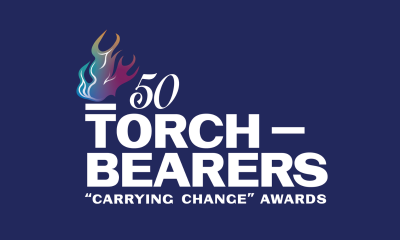Sponsored
Just Keep Swimming’: Ingleside Senior Swimmers Share Tips on Healthy Aging through Community and Daily Exercise
A range of community building and wellness opportunities abound at Ingleside, which has been recognized nationally for its inclusivity.

According to the Center for Disease Control and Prevention (CDC), the average human needs about 150 minutes of exercise per week to remain healthy as they age, but 80% of Americans aren’t checking that box.
And while there may be a plethora of reasons why “getting older” could impose on your ability to exercise as frequently as you should, three residents of Ingleside at King Farm – all 95 years young – are living proof that it is possible, and that there is no excuse.
The three neighbors, Sy Herman, Peggy Adams, and Bob Verkouteren, are using their daily commitment to swim together to encourage and inspire each other’s healthy living choices and well-being. After retiring to the Rockville, Maryland senior living community, Ingleside at King Farm, just outside of Washington, DC, the aquateers became friends through their shared love of aquatic fitness, realizing they also shared the same diligence in being at the pool each day before sunrise, meeting as early as 6:30 a.m. to swim laps.
“One morning I’m in the water and I find these two rascals here, and now we’re here together every day,” said Peggy. The friendship among the three seniors grew close over the past year ever since the trio made a deal that they would start each day at the pool before breakfast.
Science has proven that positive social relationships play a role in better health and life expectancy. Unlike forty percent of older adults in the U.S. who report chronic loneliness, Peggy, Sy and Bob, are a prime example of the positive impact meaningful relationships can have on maintaining a personal commitment to physical fitness and daily exercise.
Each morning, the seniors take turns using the fast lane at The Herman Aquatic Center at Ingleside at King Farm, challenging their endurance while also making use of water weights and other strengthening tools. The aquatic trio bonded over a shared commitment to physical exercise, community-building, and philanthropic work – all factors that health studies have shown contribute to longevity and increased quality of life.
“I took up swimming because it was a sport I could enjoy daily,” shared Sy. “I couldn’t play tennis and couldn’t play golf. So, I took up swimming, which has added years to our lives and life to our years!”
Fitness is an essential part of the Ingleside culture of living a healthy and engaged lifestyle. Ingleside’s state-of-the-art fitness facilities include a fitness center with robust programming and access to a physical trainer to tailor and support strength and cardiovascular training.
Not only does Sy use the various fitness amenities at Ingleside, but he’s also provided financial support and resources back into the senior living community to help better its aquatic facilities. Upon moving to Ingleside, Sy and his wife Sheila donated a gift to the Westminster Ingleside Foundation, with an amount specifically designated for the Aquatic Center. “It’s wonderful being here,” Sy said. “There are so many opportunities to be involved. I really love this place.”
A range of community building and wellness opportunities abound at Ingleside, which has been recognized nationally for its inclusivity.
Ingleside at King Farm, and it’s sister communities, Ingleside at Rock Creek, and Westminster at Lake Ridge were officially recognized when they received the 2023 SAGECare platinum-level lesbian, gay, bisexual, and transgender (LGBT) cultural competency certification. SAGECare is acknowledged as the foremost comprehensive, national cultural competency training program dedicated to improving the lives of older LGBT adults. Additionally, Ingleside participates in the Human Rights Campaign Foundation and SAGE’s Long-Term Care Equality Index (LEI), earning the designation as an “LGBTQ+ Long-Term Care Equality High Performer.”
“Ingleside has always been, and will continue to be committed to fostering a culture of health and inclusion,” said Christine L. Podles, MA, HSE, LNHA, Chief Operating Officer of Ingleside. “We recognize and celebrate each person’s individual uniqueness and strive to help them live a happy, healthy, and fulfilling life. It is a core value that we continue to ensure is ingrained into the fabric of the Ingleside family.”
Fitness helps lengthen lives. According to a study in Journal of Aging Research, those who exercise regularly—even for as little as three hours a week—can live up to almost 7 years longer than those who aren’t as physically active. The three swimming seniors made a pact that they would live long, healthy lives, making it to their 100th birthdays together.
“We will all be turning 100 years old within four months of each other, and I’m already sending out verbal ‘save the dates,’” said Peggy. The aquateer is already planning the party for the trio. “Mark your calendars for November 2027 – everyone is invited!”
The aquateers plan to have their celebration at no place other than The Herman Aquatic Center. Sy shared, “We’re going to have a Century Club ribbon-cutting ceremony, followed by music, dancing, and a great meal for the entire community.”
Sponsored
Safer Ways to Pay for Online Performances and Queer Events

Queer events and online performances give many people a sense of connection, identity, and artistic expression. These gatherings range from small independent drag shows streamed from home studios to large in-person events with hundreds of attendees. They help sustain performers, organizers, technicians, and community workers who rely on reliable contributions to continue creating and sharing their work.
Many people who attend or support these events want trustworthy payment options that protect both privacy and financial information. Safety matters not only because of the usual risks of online payments but also because some supporters prefer to keep their legal identity separate from the queer spaces they enjoy. This can involve concerns about outing, data exposure, or personal security. Whenever money is exchanged, the process should feel comfortable and respectful of those realities.
Paying Safely on Ticketing and Event Platforms
If we look at how heavily regulated payment systems maintain security, we can better understand what safe processing should involve. A clear example can be seen in environments where payment risks are closely monitored and tightly controlled, such as online casinos that rely on card-based transactions. Credit card casinos in the US accept familiar payment options like Visa and Mastercard, and allow instant deposits. Their systems rely on strict verification steps that confirm identity, block unauthorized access, and protect cardholders from fraud. Learning about how credit card casinos verify payments can offer useful insight into the safety measures that many reliable ticketing platforms use as well.
Queer events often partner with smaller ticketing services. These services vary in sophistication, so users benefit from paying attention to the connection type, the checkout format, and any information the site provides about privacy. A ticketing page should load with a secure connection, show recognizable payment processing partners, and avoid asking for unnecessary personal details. When a site offers a choice between credit cards and debit cards, a credit card often provides more protection. Credit card disputes also tend to be faster and involve less risk to a person’s own funds. Adding text-based verification codes to an account adds an additional layer of safety for anyone concerned about unauthorized access.
Digital Payment Options That Offer Privacy and Simplicity
More and more performers and event‑goers rely on digital payment systems because they work well. Services such as Apple Pay, Google Pay, and PayPal mask card numbers by using secure tokens. Using this plan means fewer eyes will ever see your private records. When someone pays through these tools, the artist or organizer receives confirmation of payment without gaining access to the person’s card information. If you prefer anonymity, this tool gives you extra space between your actual name and your internet footprint. It helps keep card numbers safe even if the site or app you’re using gets compromised.
Using a prepaid card adds another shield for your money. They operate independently from a person’s main bank accounts, which limits the damage if a card number is stolen. A prepaid card lets donors give quietly, because the payment isn’t linked to their main bank account. A lot of folks in the queer community value that sort of boundary, particularly when they live in places where keeping things private matters for their health. When choosing a prepaid card, it helps to pick a widely recognized brand with consumer safeguards. You’ll have protection when the card is misplaced, stolen, or a charge slips through mistakenly.
Supporting Queer Creators While Safeguarding Identity
Many queer performers rely on tips or direct contributions to cover everyday expenses and production costs. Online payment apps can reveal the payer’s full legal name, which complicates things for people who prefer to participate more quietly. To address this, supporters often turn to platforms that allow display names instead of full identity details. Ko-fi, Patreon, and Gumroad offer this type of flexibility. These services process transactions through secure systems designed to keep card information hidden at every step.
Livestream performers sometimes use encrypted direct-payment links as well. These links are simple to use and limit exposure by taking supporters straight to a protected payment page. Cryptocurrency appeals to a smaller group of supporters because it separates transactions from bank accounts, though it also carries financial risks that users should understand before relying on it regularly. Community-based support pools have also gained attention. In these systems, a group of contributors sends money into a shared fund, and the organizer distributes it to performers. This setup reduces the number of times each individual needs to enter their payment details, which can be an advantage for supporters who value privacy.
Safer Payment Choices at In-Person Queer Events
At live queer events, organizers rely on compact card readers that connect to a tablet or a smartphone. If you wander through a craft market or a late-night concert, you’ll spot these devices everywhere. Many readers accept tap-to-pay, which provides extra protection. When you tap a card or a phone, the terminal gets a token instead of the real card number. It cuts the odds of a breach and lets the transaction finish fast.
You’ll often see QR codes handy for sending a tip or a donation. Since a printed code can be swapped out by a malicious person, it’s wise to verify that the code appears purposeful and that the artist or supplier confirms it’s correct. Rather than exposing a primary credit line, certain fans prefer a prepaid card or an alias set up in their digital wallet for face-to-face payments. This reduces the chance of linking their legal name to the event while still supporting the performers they care about.
Final Thoughts
Queer events and online performances thrive when supporters feel safe and respected. Choosing appropriate payment methods plays a large part in preserving that sense of comfort. Digital wallets, prepaid cards, secure ticketing platforms, and responsible in-person practices all help protect personal information. With these tools, people can participate in queer culture while keeping control over how their financial details are used and shared. The result is a more supportive environment for both creators and the community members who sustain them.
Sponsored
6 Creative DIY Party Ideas for LGBTQ+ Celebrations

June is Pride Month, and most of the LGBTQ+ community comes together to celebrate in the shape of parades, parties, and festivals. But why limit yourself to just one month in the year to celebrate all types of love and gender expression?
You can have celebrations throughout the year and create a theme around each event to support and cheer on the queer community. From activities to drinks and snacks, there are so many ways to DIY your own unforgettable event.
1. Paint And Sip
Paint and sip events are sophisticated get-togethers, although they’ve been known to spiral into revelry every so often as the wine flows.
Setting up your own paint and sip party is easy, as long as you have access to a hobby store. Purchase a couple of canvases, oil paints, and brushes, and you’re pretty much ready to go. You should also, of course, stock up on wine or your drinks of choice.
Once your guests arrive, everyone settles down with their art supplies and starts painting. You can stick to a pride-themed painting, or have everyone paint anything they want.
2. Fabulous Casino Night
You can never go wrong with a casino night at home. Classic casino parties involve poker tables and other card games, and you can ask your guests to dress up as if they’re going to one of the top luxury casinos in Vegas.
If your friends are a bit more tech-savvy, you can show them online casino platforms, and everyone can log onto a game together to play.
It’s recommended that you get a bit of practice first if you’re new to gambling, so review resources like 99Bitcoins Telegram casino guide to practice your gambling skills on a couple of Telegram casinos before you make a fool of yourself when your guests arrive.
3. Rainbow-Themed Cocktail Evening
Who doesn’t love a rainbow-inspired event? A fun way to get everyone involved in the celebrations is to assign all your guests a color before the event, and ask them to bring the ingredients for a cocktail of that color. Think sangria for red, appletini for green, and pineapple daiquiri for yellow.
Once everyone arrives, you can get started with the mixing and tasting. As an added bit of fun, request that each of the attendees also dress up in the colors they’ve been assigned.
4. LGBTQIA+ Trivia Night
A trivia night is the perfect opportunity to test your guests’ knowledge on all things queer. Questions can include famous LGBTQIA+ personalities, organizations, or historical events.
Just be clear about the rules upfront, including how answers should be submitted and how points are scored. You should get small prizes for the winners of each round, like candy, magnets, and restaurant vouchers for the big winners.
5. Drag Bingo Night
Planning a drag bingo night is a lot of fun, but you need some organizational skills to pull it off. You will first have to hire a drag performer, or if you’re gutsy enough, dress up in drag yourself. The drag performer will act as the host, calling out the numbers and entertaining your guests.
You will also have to prepare the bingo cards. There are plenty of free online resources to help, but you will have to print out the physical cards yourself. If you feel the inspiration, customize the cards with a Pride theme.
Next, you have to source the prizes. Custom t-shirts, gift cards, or mugs are all great bingo prizes. Or, you can make a donation in the winner’s name to an LGBTQIA+ charity.
Once your guests arrive, the fun can start. Online bingo platforms can do the number draws for you, or you can do it old school-style and add a couple of numbered balls to a box.
6. Pride-Themed Movie Night
A chilled movie night can also be a fun celebration, especially if you’re watching a queer-friendly film.
Some options include:
- Brokeback Mountain
- Love, Simon
- Call Me By Your Name
- Girl
- Moonlight
- Paris Is Building
- Pariah
Invite your guests to arrive in comfy clothes or pyjamas, and create a cozy atmosphere with lots of blankets, scatter cushions, soft seating, and of course, the typical movie snacks like popcorn and pizza.
If it’s your type of thing, you can encourage discussion about the movie once it is completed, like metaphors in the film, or whether anyone has had similar experiences to the characters.
Wrapping Up
Celebrating the queer community with a party at home can be easy with a little creative inspiration and some prior planning. What really matters when hosting is how you make your guests feel. The LGBTQIA+ community often faces discrimination and other challenges, and your role as host is to provide a safe, fun, and welcoming atmosphere for everyone in attendance.
Sponsored
Forget what you thought you knew about senior living.
Bountiful amenities and myriad program offerings provide countless opportunities to explore, learn, and connect.

A focus on wellness. A wide array of concierge services, an executive pastry chef, and skilled mixologist. Technology baked into mobile apps and smart homes. Luxe touches within the big and small details that matter.
They all come together at The Mather in Tysons, Virgina, a forward-thinking Life Plan Community that upends all the stereotypes of traditional senior living. It’s a residential wellness destination for those 62 and better, consisting of 288 luxury apartment homes. And it’s 90% sold!
One of the most sought-after residences in Northern Virginia, The Mather is THE destination if you’re focused on aging well. If you want to be immersed in new cultural experiences, art, food and nature. If you expect more out of living well.
At the heart of this award-winning community is wellness, which was embedded in the design from day one. The property features 3-acres of green space with walking trails, a concert lawn and dog park – much of which is accessible to the public. You can wander through sculpture gardens, stroll on walking paths, play bocce or badminton, or linger with friends at one of the fire tables and patios.

Biophilic design throughout connects residents to the outdoors even when inside. The careful inclusion of nature within architecture is proven to nurture well-being. At The Mather, it comes to life through elements such as natural light, greenery, and wood materials which invite a sense of calm that’s often missing from modern indoor spaces. A commitment to using sustainable materials and creating a paperless environment contribute to caring for our planet.
When visiting, take time to explore the fitness center, which is equipped with advanced cardio and strength-training equipment, percussive therapy tools, and an AI-enabled body composition analyzer.
You might see residents enjoying a group class in Pilates, or practicing yoga or tai chi on the outdoor terrace. A heated indoor pool and infrared sauna are spaces for aquatic exercise and rejuvenation.
The full-service spa, Marzenia, offers a holistic menu of traditional spa treatments, including the Gharieni’s Welnamis wave bed, which uses sound and vibration to promote deep relaxation, and a Breath Lounge.
Culinary experiences at The Mather rival those of a high-end resort, with multiple on-site restaurants that curate global cuisine, as well as a bakery and pastry kitchen, and a bar+lounge with its own mixologist. Among them are all-day restaurant Maku (Finnish for savor), modern causal restaurant with outdoor seating Saam (Afrikaans for together), refined dinner venue Tashi (Tibetan for good fortune) and bar and social hub Copas (Spanish for drinks).
Staying in for the evening? Choose delivery by Gusta, a robot named for the Italian word for “enjoy,” who’ll bring a meal directly to the doorstep.
Gusta is just one way technology is integrated throughout the community. Each apartment home comes equipped with complimentary Wi-Fi and Alexa devices to control lighting, temperature, window shades, and more. Residents use digital platforms to reserve tables, request valet service, or schedule housekeeping. Of course, you can always visit, call, or text the concierge, who will personally arrange services from pet care to travel notifications.
Connection is encouraged through beautifully designed gathering spaces such as Kia Ora, a living-room lounge perfect for conversation, as well as a library stocked with books and periodicals.
Much more than a place to live, The Mather is a place to define your path to aging well, discover new interests and live boldly.
If you see yourself here, visit themathertysons.com.
-

 U.S. Supreme Court4 days ago
U.S. Supreme Court4 days agoSupreme Court hears arguments in two critical cases on trans sports bans
-

 Virginia5 days ago
Virginia5 days agoWoman arrested for anti-gay assault at Alexandria supermarket
-

 Commentary4 days ago
Commentary4 days agoHonoring 50 queer, trans women with inaugural ‘Carrying Change’ awards
-

 District of Columbia4 days ago
District of Columbia4 days agoRuby Corado sentenced to 33 months in prison




















